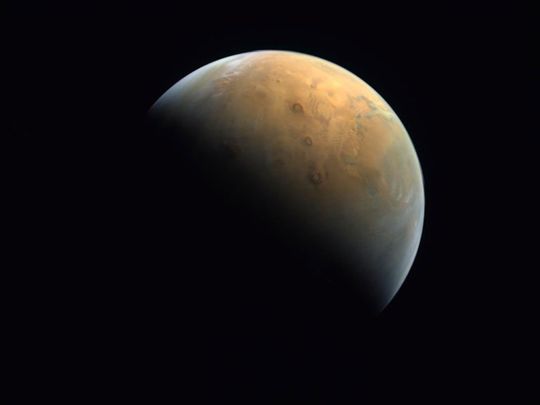
Dubai: His Highness Sheikh Mohammed bin Rashid Al Maktoum, Vice-President and Prime Minister of the UAE and Ruler of Dubai and His Highness Sheikh Mohamed Bin Zayed Al Nahyan, Crown Prince of Abu Dhabi and Deputy Supreme Commander of the UAE Armed Forces, have tweeted the first picture transmitted by Hope Probe from Mars.
"The transmission of the Hope Probe's first image of Mars is a defining moment in our history and marks the UAE joining advanced nations involved in space exploration. We hope this mission will lead to new discoveries about Mars which will benefit humanity," Sheikh Mohamed tweeted.
Hope Probe successfully entered the Mars orbit on February 9
The Hope Probe successfully entered the Mars orbit on February 9. The Hope Probe, built by Emirati engineers, was launched from Tanegashima, Japan, on July 20, 2020.
With its three scientific instruments, Hope Probe will map a complete portrait of the Martian atmosphere and evaluate its seasonal and daily changes. It will collect more than one terabyte (1,000GB) of new data, which will be shared with more than 200 academic and scientific institutions worldwide for free.
All you need to know about Hope Probe
- UAE proves impossible is possible: UAE Hope Probe successfully enters Mars' orbit
- Meet the Emirati engineers of Hope Probe Mars Mission
- Arab world celebrates: Landmarks light up in red as Hope Probe enters Mars orbit
- UAE Mars Mission: Hope Probe is healthy and ready to move to Science phase
- Sheikh Hamdan, Sheikh Maktoum and Sheikh Ahmed hail UAE Hope Probe success
There are several spacecraft orbiting Mars, but they all follow paths around the equator and only see a particular area of the planet each day. Hope Probe will circle the equator, allowing it to get a complete picture of the planet every nine days — including every spot on the surface every day.
The scientific instruments will allow Hope to observe Mars’ atmosphere in wavelengths from the infrared into the far-ultraviolet.
‘EMM catches Olympus Mons at Sunrise’
Titled ‘EMM catches Olympus Mons at Sunrise’, the picture was taken by the EXI digital exploration camera, one of EMM’s three scientific instruments. It is a multi-wavelength radiation tolerant camera that can take 12-megapixel images and took the image from an altitude of around 25,000km above the Martian surface.
The flexible readout modes allow customisation of resolution, regions of interest and frame rate to meet the needs of the user. The colour is created from a composite of red, green, and blue EXI images. The North pole of Mars is in the upper left of the image.
Largest volcano
EMM captured the largest volcano in the solar system, Olympus Mons (centre), emerging into the early morning sunlight. More prominent are the three large shield volcanoes of Tharsis Montes (Ascraeus Mons, Pavonis Mons, and Arisia Mons).
Further to the East or right of the volcanoes lie Noctis Labyrinthus and the Valles Marineris system of canyons, filled with clouds. Ice clouds are present over the southern highlands (lower right) as well as surrounding the volcano Alba Mons (upper left). Clouds can also be seen above the limb (top of image and middle right, when looking between the planet and space). These clouds, seen in different geographic regions and at different times of day, provide a preview of EMM’s contributions to our understanding of the Martian atmosphere.
The picture is the first of more than 1,000 GB of new Mars data that the Probe will send back to earth and that will be shared for free with more than 200 academic and scientific institutions around the world.
Studies
For the first time, it will study the link between weather change and atmospheric loss, a process that may have caused the Red Planet’s surface corrosion and the loss of its upper atmosphere.
The mission will provide deeper insights on the climatic dynamics of the Red Planet through observing the weather phenomena in Mars such as the massive famous dust storms that have been known to engulf the Red Planet, as compared to the short and localised dust storms on earth. It will focus on better understanding the link between weather changes in Mars’ lower atmosphere, with the loss of hydrogen and oxygen from the upper layers of the atmosphere.
Scientific instruments
The Hope Probe also carries the second infrared spectrometer, Emirates Mars Infrared Spectrometer (EMIRS), which studies the lower atmosphere of the Red Planet in the infrared band, measures the global distribution of dust, ice clouds, water vapours, and temperature profiles, and provides the linkages from the lower to the upper atmosphere in conjunction with EMUS and EXI observations,
The third instrument carried by the probe to study Mars is the Emirates Mars Ultraviolet Spectrometer (EMUS). It detects ultraviolet wavelength and determines the abundance and variability of carbon monoxide and oxygen in the thermosphere on sub-seasonal timescales. It also calculates the three-dimensional structure and variability of oxygen and hydrogen in the exosphere and measures the relative changes in the thermosphere.
A successful fourth stage
The UAE made history on Tuesday evening, February 9, as the first Arab nation, and the fifth in the world, to reach Mars after the Hope Probe successfully entered the Red Planet’s orbit at 7:42pm.
The probe’s entry to Mars’ orbit marks the end of four of the six stages of its space journey that started in July 20, 2020: Launch, Early Operations, Cruise and The Mars Orbit Insertion. The probe is currently entering the ‘transition to science’ phase, before it commences the ‘science’ phase to study the Martian atmosphere.
The last phase of the probe’s journey is set to begin in April. The probe will officially enter the Science phase to complete the first-ever planet-wide, 24x7 picture of Mars’ atmospheric dynamics and weather daily, throughout all seasons for one full Martian year (687 earth days) until April 2023. The probe, however, can be used for another two years for additional data collection.








